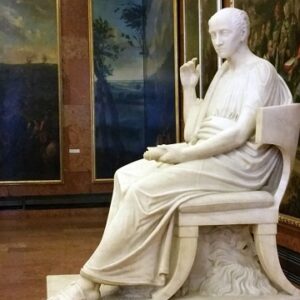István Ferenczy was a well-known Hungarian sculptor in the nineteenth century. He was apprenticed to his father, a locksmith, because he was expected to follow in his father’s footsteps. The young István, on the other hand, was a talented artist who had set his sights on making magnificent works of art. He enrolled in a copperplate engraving course at the Vienna Academy, where his work was highly praised. He eventually developed a strong interest in sculpture and studied at the Academy under Fischer and Kleiber. He was completely devoted to art and studied for several years with the goal of becoming a sculptor. Despite his innate abilities and determination, he frequently felt lonely and disillusioned with his work. That isn’t to say he didn’t succeed professionally—he did—but it was never the kind of success he had envisioned for himself. Over the course of his work, he modeled countless portraits of prominent figures, built tombs and memorials, and sculpted several popular statues. He had a lifelong ambition to build a sculpture school in Hungary, but he was unable to do it during his lifetime.
Childhood and Adolescence
István Ferenczy was born on February 24, 1792, in Rimaszombat (now Rimavská Sobota, Slovakia). His father was a locksmith, and he grew up in a family of locksmiths.
He was a brilliant young child with a natural affinity for the arts. His parents, on the other hand, wanted him to follow in his father’s footsteps, so he was apprenticed to him.
He wanted to be an artist because he was naturally brilliant and gifted with an artistic bent of mind. His parents, on the other hand, urged him to pursue a more secure career that paid handsomely, as artists could hardly make ends meet in those days.
István was adamant, and his parents eventually relented. He originally studied copperplate engraving at the Vienna Academy, where he received the prize “Solon” for his efforts.
In 1817, he went to the Academy of Fine Arts to study sculpting under Fischer and Kleiber. He proceeded to Rome the following year, hoping to study under Antonio Canova, the greatest Neoclassicist, and eventually establish sculpture in his birthplace.
When he arrived in Rome, however, he was unable to secure a spot at Canova’s studio. Fortunately, he was accepted as a student by another famous artist, Danish sculptor Bertel Thorvaldsen. He worked in Thorvaldsen’s workshop for the next six years.
István Ferenczy was a great student who quickly began producing magnificent works of art. Despite the fact that he had yet to transmit any of his works to Hungary, journalists in his native country were eager to view them so that they could report on them.
In 1819, he sent his first works to Hungary: ‘Reposing Venus,’ ‘Portrait of Csokonai,’ and ‘Shepherdess or the Beginning of Fine Crafts.’ His artistic talents helped him win multiple scholarships, allowing him to pursue his long-held desire of studying for two years under the great Canova.
In 1822, István Ferenczy sent two of his sculptures to Hungary, addressed to Palatine Joseph Habsburg, the Austrian administrator of Hungary and a well-known patron of Hungarian culture, who publicly displayed them.
He aspired to construct memorials to famous personalities in Hungarian history as a sculptor. He considered that cultural heroes were just as essential as military heroes, thus he dedicated his first memorial to the poet Mihály Csokonai Vitéz.
When he merged a traditional Hungarian garment with an ancient toga in the bust of Mihály Csokonai Vitéz, he applied the stylistic principles of Neoclassical sculpture to his Hungarian subject matter.
István Ferenczy was a very idealistic person who wished to use his talents to benefit his country by making historical figure memorials to inspire future generations. He saw himself as a thinker who created works as a result of his intellectual pursuits.
During his time in Rome, he dreamed of a bright future for himself. However, upon his return to Hungary, he was received with a great deal of disappointment. He desired the freedom to work as he pleased, as well as the opportunity to contribute to the enrichment of Hungarian culture. Things, however, did not turn out as he had hoped.
He anticipated to be treated with the same respect and appreciation in Hungary as he was in Rome, Europe’s center of art and culture, where outstanding painters were respected. High art, on the other hand, was not well received in Hungary. There were no public art galleries, exhibitions, or art criticism at the time. As a result, he was unable to obtain the professional environment that he desired.
By the 1830s, he had modeled portraits (‘Ürmélyi’, ‘Rudnay’, ‘Kazinczy’, and others), tombs (‘Kulcsár’, ‘Szánthó’, ‘Fornay’), and altarpieces (‘The Blessed’ in Vál, ‘The Martyrdom of St. Stephen’ in Esztergom), as well as some other works.
Throughout the 1840s, he continued to produce, despite being irritated and disappointed with the state of Hungarian art. In 1846, he finished his last great piece, the ‘Statue of Kölcsey,’ and in 1847, he stopped working on huge sculptures.
Throughout his career, he attempted several times to create a sculpture school in Hungary in order to promote indigenous art. He was, however, unable to do so within his lifetime. Ferenczy’s paintings played a vital impact in shaping 19th century Hungarian art, despite the fact that he did not consider himself to be particularly successful.
Personal History and Legacy
Istvan Ferenczy died at the age of 64 in Rimaszombat in 1856.
Estimated Net Worth
The estimated Net Worth of István Ferenczy is unknown.


